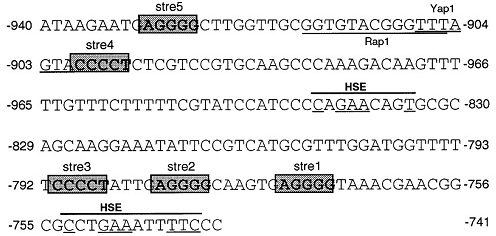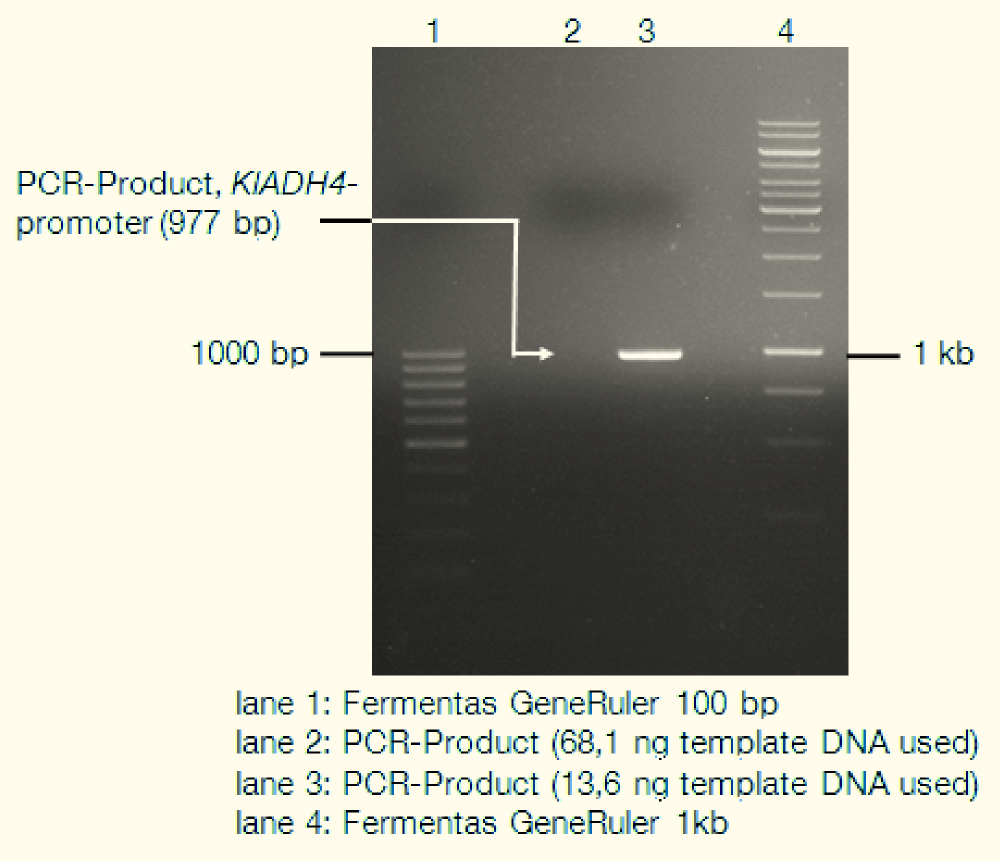Team:TU Munich/Project/Ethanol Inducible Promoter
From 2012.igem.org
(→Ethanol Inducible Promoter) |
Simon Heinze (Talk | contribs) (→References) |
||
| Line 75: | Line 75: | ||
* Kuge S., Jones N. (1994) ,YAP1 dependent activation of TRX2 is essential for the response of ''S. cerevisiae'' to oxidative stress by hydroperoxides', ''EMBO J.'' '''13''', 655–664. PMID: 8313910 | * Kuge S., Jones N. (1994) ,YAP1 dependent activation of TRX2 is essential for the response of ''S. cerevisiae'' to oxidative stress by hydroperoxides', ''EMBO J.'' '''13''', 655–664. PMID: 8313910 | ||
| + | |||
| + | * Saliola, M., Mazzoni, C., Solimando, N., Crisà, A.,Falcone, C. & Jung, G. (1999) ‚Use of the KlADH4 promoter for ethanol-dependent production of recombinant human serum albumin in Kluyveromyces lactis’, Appl Environ Microbiol. 65(1), 53-60 | ||
* Shore D., Nasmyth K. (1987) ,Purification and cloning of a DNA binding protein from yeast that binds to both silencer and activator elements', ''Cell'' '''51 (5)''' 721-32. PMID: 3315231 | * Shore D., Nasmyth K. (1987) ,Purification and cloning of a DNA binding protein from yeast that binds to both silencer and activator elements', ''Cell'' '''51 (5)''' 721-32. PMID: 3315231 | ||
Revision as of 01:15, 27 September 2012



Contents |
Ethanol Inducible Promoter
An ethanol inducible promoter - that would really be handy in brewing a beer with transgenic yeast! According to the German Purity Law, no ingredients other than water, hops and barley may be used for brewing - which is why we can't simply add a chemical to induce gene expression at the desired point of time. But constitutive promoters are not always the best solution, so we thought about substances that "appear" during brewing. And of course we came up with - Alcohol! Alcohol would be the ideal inducing agent because the yeast cells could take care of the main fermentation first, without any heterologous pathways hindering them. Then, after the main fermentation is completed and therefore ethanol is present, the heterologous genes would be induced and the yeast would produce our desired substances.
Another application for an alcohol inducible promoter is that of a classic biosensor. If cloned in front of a classic reporter gene such as GFP, the fluorescence could be used to deduce the current ethanol content, thus abolishing the need for complicated enzyme assays or distillation experiments, which are currently among the most applied tools for measuring the alcohol content in beverages.
We chose the KlADH4-promoter because it originates from a close relative of S. cerevisiae - Kluyveromyces lactis. It has been reported that promoters can be interchanged between those two species and in addition to that, all transcription factors and cis-elemtents known to be involved in the alcohol response of the KlADH4 promoter in K. lactis also occur in S. cerevisiae (Mazzoni et al., 2000). Because of that, we do not need to express genes for any additional transcription factors.
Background and principles
Original organism: Kluyveromyces lactis
K. lactis is a crabtree-negative yeast, which means it does not produce ethanol under aerobic conditions. S. cerevisiae, on the other hand, is crabtree-positive. Another interesting fact about K. lactis is its ability to grow on ethanol as the only carbon source (Breunig et al., 1999, [http://www.ncbi.nlm.nih.gov/pubmed?term=10862884]).
KlADH4
The K. lactis gene KlADH4 encodes a mitochondrial Alcohol Dehydrogenase which can be specifically induced by ethanol and is insensitive to glucose repression. A small region in the KlADH4 promoter, called UASE, is responsible for expression of the gene in presence of ethanol (Mazzoni et al., 2000 [http://www.ncbi.nlm.nih.gov/pubmed?term=10724480]). UASE is a cis-element of the KlADH4 promoter spanning from -953 to -741. When inserted into the promoters of heterologous genes, these genes become ethanol-inducible.
The sequence contains (Mazzoni et al. 2000):
- a putative binding site for Yap1p between -906/-900, a transcription factor involved in stress response in S. cerevisiae and K. lactis
- consensus sequence of the binding site of Rap1 protein. RAP1 (repressor activator protein 1) is an essential gene present in both S. cerevisiae and K. lactis and acts positively or negatively on the expression of many genes. Rap1 binding sites have been found in promoters of glycolytic genes where they play a positive role in transcription.
- Five STREs (stress response elements). STREs have been found in the promoters of many S. cerevisiae genes, where they are present in two or more copies in both orientations
- Two HSEs (heat shock elements). HSEs have been found in combination with STREs in many stress-responsive genes of S. cerevisiae.
Despite the presence of the STREs, KlADH4 is not a stress responsive gene but specifically induced by alcohol (Mazzoni et al., 2000).
Idea
Although there is evidence that the KlADH4 promoter can be used for ethanol dependent production of recombinant proteins in K. lactis ([http://www.ncbi.nlm.nih.gov/pubmed/9872759 Saliola et al. 1999]), we did not find any literature which indicated that this alcohol-inducible promoter has been used in other organisms such as S. cerevisiae.
Mazzoni et. al (2000) annotated binding sites for two transcription factors (Rap1 and Yap1) as well as some small cis-elements (HSEs and STREs) in the UASE-region of the KlADH4-promoter. All of these factors are not only present in K. lactis but also in S. cerevisiae (Kuge & Jones, 1994 [http://www.ncbi.nlm.nih.gov/pubmed?term=8313910], Shore & Nasmyth, 1987 [http://www.ncbi.nlm.nih.gov/pubmed?term=3315231], Schueller et al., 1994 [http://www.ncbi.nlm.nih.gov/pubmed?term=7523111], Ruis & Schueller, 1995 [http://www.ncbi.nlm.nih.gov/pubmed?term=8526890]).
General Remarks
S. cerevisiae is a very potent brewer and quickly produces alcohol. This made negative controls during the characterization of the KlADH4-promoter difficult.
Results
Extraction of the KlADH4-promoter from genomic DNA of K. lactis
We isolated genomic DNA from K. lactis using the LiOAc-SDS-method ([http://www.ncbi.nlm.nih.gov/pubmed?term=21548894 Looke et al. 2011] and used this gDNA as template for PCR. The following gel picture documents the success of this:
We also sequenced the construct for verification (data not shown) and found some single point mutations compared to the published genome sequence of K. lactis. These are not in any conserved regions and should have no influence on the promoters functionality.
Characterization of the KlADH4-promoter using eGFP
References
- Breunig KD., Bolotin-Fukuhara M., Bianchi MM., Bourgarel D., Falcone C., Ferrero I I., Frontali L., Goffrini P., Krijger JJ., Mazzoni C., Milkowski C., Steensma HY., Wésolowski-Louvel M., Zeeman AM. (2000),'Regulation of primary carbon metabolism in Kluyveromyces lactis', Enzyme Microb Technol. 26 (9-10), 771-780. PMID: 10862884
- Mazzoni, C., Santori, F., Saliola, M. & Falcone, C. (2000) ‚Molecular analysis of UASE, a cis element containing stress response elements responsible for ethanol induction of the KlADH4 gene of Kluyveromyces lactis’, Res. Microbiol. 151, 19-28. PMID: 10724480
- Kuge S., Jones N. (1994) ,YAP1 dependent activation of TRX2 is essential for the response of S. cerevisiae to oxidative stress by hydroperoxides', EMBO J. 13, 655–664. PMID: 8313910
- Saliola, M., Mazzoni, C., Solimando, N., Crisà, A.,Falcone, C. & Jung, G. (1999) ‚Use of the KlADH4 promoter for ethanol-dependent production of recombinant human serum albumin in Kluyveromyces lactis’, Appl Environ Microbiol. 65(1), 53-60
- Shore D., Nasmyth K. (1987) ,Purification and cloning of a DNA binding protein from yeast that binds to both silencer and activator elements', Cell 51 (5) 721-32. PMID: 3315231
- Schüller C, Brewster JL, Alexander MR, Gustin MC, Ruis H. (1994) ,The HOG pathway controls osmotic regulation of transcription via the stress response element (STRE) of the Saccharomyces cerevisiae CTT1 gene', EMBO J. 13(18) 4382-9. PMID: 7523111
- Ruis H, Schüller C. (1995) ,Stress signaling in yeast',Bioessays. 17(11) 959-65. PMID: 8526890
 "
"


